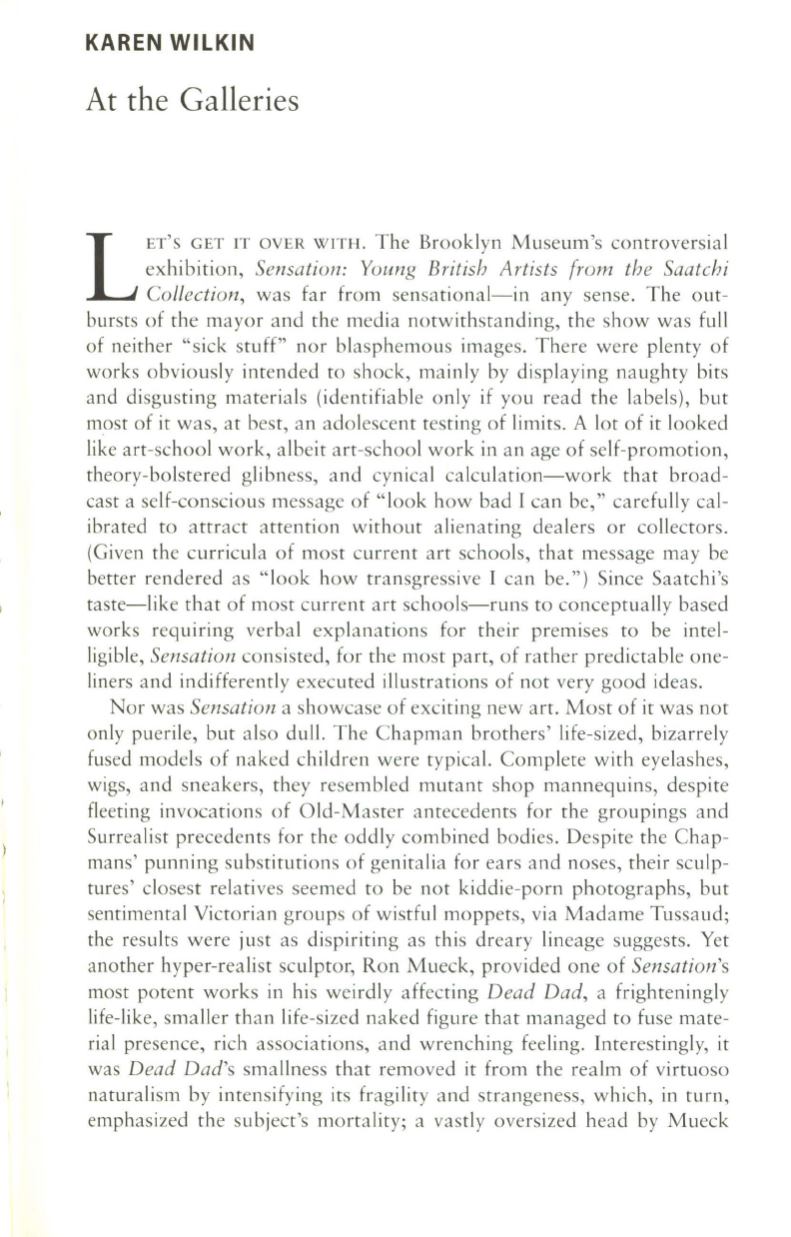
KAREN WILKIN
At the Galleries
L
ET'S GET IT OVER WITH.
The Brooklyn Museum's controversial
exhibition,
Sensation: Young British Artists from the Saatchi
Collection,
was far from sensational-in any sense. The out–
bursts of the mayor and the media notwithstanding, the show was full
of neither "sick stuff" nor blasphemous images. There were plenty of
works obviously intended to shock, mainly by displaying naughty bits
and disgusting materials (identifiable only if you read the labels), but
most of it was, at best, an adolescent testing of limits. A lot of it looked
like art-schoo l work, albeit art-school work in an age of self-promotion,
theory-bolstered glibness, and cynical calculation-work that broad–
cast a self-conscious message of " look how bad I can be," carefully cal–
ibrated to attract attention without alienating dealers or collectors.
(Given the curricula of most current art schools, that message may be
better rendered as "look how transgressive I can be.") Since Saatchi's
taste-like that of most current art schools-runs to conceptually based
works requiring verbal exp lanations for their premises to be intel–
ligible,
Sensation
consisted, for the most part, of rather predictable one–
liners and indifferently executed illustrations of not very good ideas.
Nor was
Sensation
a showcase of exciting new art. Most of it was not
only puerile, but a lso dull. The Chapman brothers' life-sized, bizarrely
fused models of naked children were typical. Complete with eyelashes,
wigs, and sneakers, they resembled mutant shop mannequins, despite
fleeting invocations of Old-Master antecedents for the groupings and
Surrealist precedents for the oddly combined bodies. Despite the Chap–
mans' punning substitutions of genitalia for ears and noses, their sculp–
tures' closest relatives seemed to be not kiddie-porn photographs, but
sentimental Victorian groups of wistful moppets, via Madame Tussaud;
the results were just as dispiriting as this dreary lineage suggests. Yet
another hyper-realist sculptor, Ron Mueck, provided one of
Sensation's
most potent works in his weirdly affecting
Dead Dad,
a frighteningly
life-like, smaller than life-sized naked figure that managed to fuse mate–
rial presence, rich associations, and wrenching feeling. Interestingly, it
was
Dead Dad's
smallness that removed it from the realm of virtuoso
naturalism by intensifying its fragility and strangeness, which, in turn,
emphasized the subject's mortality; a vastly oversized head by Mueck


